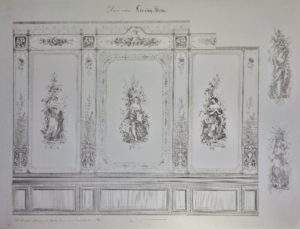This paper attributed to the wallpaper manufacturer Delicourt depicts the Roman goddess Juno and would have been part of a set of panels that featured members of the Roman pantheon. The accompanying panels would have likely shown Juno’s husband Jupiter as well as two or three other gods, and the whole set would possibly have been arranged on the wall with additional printed decoration in a manner similar to a set of the Five Senses illustrated in a Delicourt catalogue owned by the Cooper-Hewitt Library.

Delicourt & Cie., Collection d’esquisses des articles de décoration exécutés en papier peint dans la manufacture de Délicourt & Cie., Rue de Charenton, no. 155 et 157 à Paris [Paris : Délicourt & Cie., 18–], Cooper-Hewitt Design Library
Delicourt was founded in 1838 by Étienne Delicourt, a former worker at the popular wallpaper manufacturer Dufour. While never as successful as Dufour or its rival Zuber et Cie., Delicourt maintained a steady business, employing at one point over three hundred workers, and earned acclaim at the international expositions of the 1850s. Delicourt’s panoramic scenic La Grande Chasse, “The Great Hunt,” won the only “Council Medal” awarded to a wallpaper at the 1851 Great Exhibition in London, while the firm’s showing at the 1853 New York World’s Fair won a bronze medal. However, the company would cease to exist in 1860, when it was bought out by another manufacturer Les Frères Hoock. Étienne also found minor success as a color theorist. His 1847 work Album du contraste simultané des couleurs d’après le système de M. Chevreul was so successful in its use of wallpaper samples to illustrate Michel Chevreul’s concept of the simultaneous contrast of color that he was mentioned by the latter author in his own work. Delicourt’s interest in color is apparent in the delicate coloring of this panel. Ultimately, the paper is a beautiful example of the production of this little-known but significant manufacturer.
Nicholas Lopes is a student in the History of Design & Curatorial Studies graduate program at the Cooper Hewitt, and is a Master’s Fellow in the Wallcoverings Department.
References on Delicourt:
Catalogue, Issues 141-149. London: Bernard Quaritch, Ltd., 1894.
Chevreul, Michel Eugène. Complément des études sur la vision des couleurs. Paris: Firmin-Didot, 1879.
Exposition universelle de 1851: Travaux de la commission française sur l’industrie des nations. Paris: Imprimerie Impériale, 1855.
Lynn, Catherine. Wallpaper in America: From the Seventeenth Century to World War I. New York: W.W. Norton, c1980.
